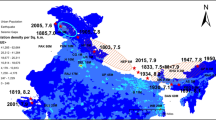Abstract
Ground motion database from the region of Żelazny Most tailings pond, the largest in Europe ore-flotation waste repository, is used to identify ground motion prediction equations (GMPE-s) for peak horizontal and peak vertical acceleration. A GMPE model including both geometrical spreading and anelastic damping terms cannot be correctly identified and the model with only spreading term is accepted. The analysis of variance of this model’s residuals with station location as grouping variable indicates that station locations contribute significantly to the observed ground motion variability. Therefore, a site specific GMPE model with relative site amplifications is assessed. Despite short distances among stations, the amplification considerably vary from point to point, up to 1.8 times for the horizontal and 3.5 times for the vertical peak amplitude. The model including site effects enhances GMPE-s fit to observations, explains more than 60% dependent variables variability and correctly accounts for site effects.
Similar content being viewed by others
References
Anderson, J.G., and Y. Uchiyama (2011), A methodology to improve ground-motion prediction equations by including path corrections, Bull. Seismol. Soc. Am. 101,4, 1822–1846, DOI: 10.1785/0120090359.
Douglas, J. (2008), Further errata of and additions to “Ground motion estimation equations 1964–2003”, Final Report BRGM/RP-56187-FR, Orléans, France.
Golik, A., and M.J. Mendecki (2012), Ground-motion prediction equations for induced seismicity in the Main Anticline and Main Syncline, Upper Silesian Coal Basin, Poland, Acta Geophys. 60,2, 410–425, DOI: 10.2478/s11600-011-0070-9.
Joyner, W.B., and D.M. Boore (1993), Methods for regression analysis of strongmotion data, Bull. Seismol. Soc. Am. 83,2, 469–487.
Lasocki, S. (2002), Attenuation relation for horizontal component of peak ground acceleration below 10 Hz frequency for the Polkowice region, Publs. Inst. Geophys. Pol. Acad. Sci. M-27,352, 79–90 (in Polish).
Lasocki, S. (2005), Probabilistic analysis of seismic hazard posed by mining induced events. In: Y. Potvin and M. Hudyma (eds.), Proc. Sixth Int. Symp. on Rockburst and Seismicity in Mines “Controlling Seismic Risk”, 9–11 March 2005, Australia, Australian Centre for Geomechanics, Nedlands, 151–156.
Lasocki, S. (2009), Key-note lecture: Probabilistic seismic hazard analysis for mining-induced seismicity. In: C. Tang (ed.), Proc. Seventh Int. Symp. on Rockburst and Seismicity in Mines “Controlling Seismic Hazard and Sustainable Development of Deep Mines”, 21–23 August 2009, Dalian, China, Rinton Press, New York, 59–72.
Lasocki, S., and D. Olszewska (2003), The influence of non-homogeneous local effects on the accuracy of prediction of strong ground motion propagation: An example from the town Polkowice region. In: E. Pilecka (ed.), Proc. 8th Mining Workshop “Natural Hazards in Mining”, Wyd. IGSMiE PAN, Kraków, 113–126 (in Polish).
Lasocki, S., and B. Orlecka-Sikora (2002), Prediction of soil vibrations for Polkowice in 2001–2013. In: D. Flisiak (ed.), Proc. 25th Winter School of Rock Mechanics, Wyd. Katedry Geomechaniki, Budownictwa i Geotechniki AGH, Kraków, 369–384 (in Polish).
Massa, M., P. Morasca, L. Moratto, S. Marzorati, G. Costa, and D. Spallarossa (2008), Empirical ground-motion prediction equations for Northern Italy using weak- and strong-motion amplitudes, frequency content, and duration parameters, Bull. Seismol. Soc. Am. 98,3, 1319–1342, DOI: 10.1785/ 0120070164.
McGarr, A., and J.B. Fletcher (2005), Development of ground-motion prediction equations relevant to shallow mining-induced seismicity in the Trail Mountain area, Emery County, Utah, Bull. Seismol. Soc. Am. 95,1, 31–47, DOI: 10.1785/0120040046.
Olszewska, D. (2006), Attenuation relations of ground motion acceleration response spectra for the Polkowice Region, Publs. Inst. Geophys. Pol. Acad. Sci. M-29,395, 161–174.
Orlecka-Sikora, B., S. Cesca, S. Lasocki, G. Lizurek, P. Wiejacz, Ł. Rudziński, P. Urban, and M. Kozłowska (2012), Complex source mechanisms of mining-induced seismic events and their exceptional surface impacts: the case from Rudna copper-ore mine in Poland, Geophys. J. Int. (submitted).
Author information
Authors and Affiliations
Corresponding author
Rights and permissions
About this article
Cite this article
Lasocki, S. Site specific prediction equations for peak acceleration of ground motion due to earthquakes induced by underground mining in Legnica-Głogów Copper District in Poland. Acta Geophys. 61, 1130–1155 (2013). https://doi.org/10.2478/s11600-013-0139-8
Received:
Revised:
Accepted:
Published:
Issue Date:
DOI: https://doi.org/10.2478/s11600-013-0139-8




